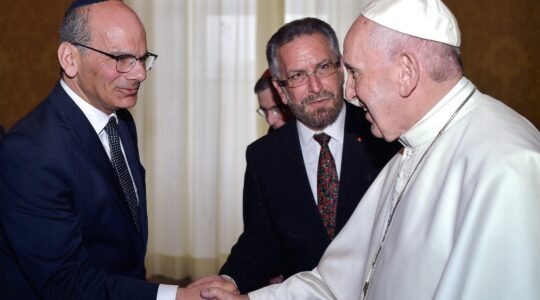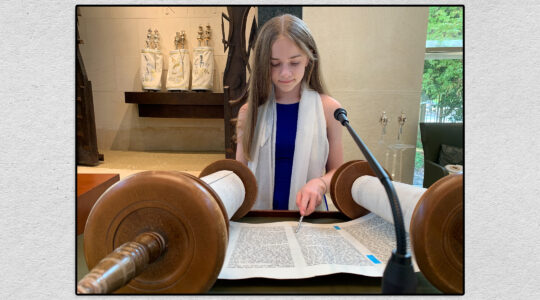When 18-year-old Margot Haas visited Rwanda’s Agahozo-Shalom Youth Village on a summer service and learning trip, she was described by her mom as “ambiently Jewish.” The term itself reflects the gap between what so many “next generation” Jews think of themselves and how they are thought of by their parents and teachers.
What is often thought of by the former as a weak connection to Jewishness, is often experienced as a deeply felt connection looking for new forms of expression, better reflecting how younger people connect to themselves and others in today’s world. That was certainly true for Margot.
Having experienced genuine integration, the teen came back from the community, which is based on the Yemin Orde Youth Village in Israel, looking for new ways to fully honor and integrate her understandings of both Jewish engagement and global outlook.
This new perspective spurred her to deepen her relationship to Israel. Haas said the trip made her want to “learn more about my religion … to speak Hebrew fluently, so maybe I can study a year abroad in Israel.” Going global invited Margot to go more deeply into her own Jewishness. Rather than the two being opposed, each invited more of the other.
At the Abayudaya Jewish Community of Uganda, visitors experience bar and bat mitzvah services that blend familiar Jewish ritual with the unique customs of this African community. The mixing of traditions extends to the tzedakah (charity) often linked to these celebrations, which are led by Rabbi Gershom Sizomu, a graduate of Ziegler School of Rabbinic Studies at the American Jewish University.
Moved by their experiences, guests contribute to projects of The Tobin Health Center, in Mbale, Uganda, that provide clean water, mosquito nets to combat malaria, pre/post natal care and various daily medical services. “Water is life and sanitation is health,” explained Saul Ekusai, an administrator of the health center. The improved healthcare and community development has fostered increased cooperation between the Abayudaya and their Christian and Muslim neighbors who also benefit from the health center projects.
These two examples of what might be termed “global Judaism” demonstrate how the next generation of Jews can learn from communities and experiences often left out of the Jewish story commonly told in America. By going global, members of the next generation have expanded their geographical, intellectual, ethical and yes, philanthropic imagination, and have begun to redefine notions of community and responsibility along the way.
Especially in America, where the contemporary Jewish community has increasingly permeable borders, we are rethinking our neighborhood. More specifically, how is Jewish philanthropy affected by living in this new neighborhood? How are old conceptions challenged, and equally old traditions more fully embraced?
Tzedakah remains a powerful creator and reinforcer of ethnic, cultural and religious values. Even as Jews from the baby boom and next generations give less to synagogues and religiously affiliated institutions, they report having deeply held beliefs about righteousness, justice and protection of the vulnerable.
The steady expansion from Jews giving to centralized institutions which cared virtually exclusively for other Jews in one’s geographic neighborhood, to Jews giving globally to similar organizations, is morphing once again. Jewish philanthropy is shifting to causes that are geographically global and meet needs within and beyond the Jewish people.
Jewish philanthropy has traditionally been a matter of proximity — the classical statement being that the poor of one’s city take precedence. Physical proximity determined priority, sometimes even placing the needs of local non-Jews ahead of the needs of Jews living far away. But where is “one’s city” when we live in a world increasingly described as a global village?
In 2009, according to Giving USA, international philanthropy rose by 6 percent, and in 2010 it rose by 15 percent, which was the largest increase in any subsector of giving that year. This compares to more or less flat domestic giving during the same period. The message: Global matters increasingly shape our philanthropic priorities.
Over the last decade, there has been a noticeable boom in innovative nonprofits that are responding to Jewish needs, especially spiritual and intellectual needs. Rather than starting with a definition of what Jewish is, they start by looking carefully at and listening closely for what people want from Judaism, helping them to use thousands of years of tradition to create more meaningful and ethical lives.
Traditionally, Jewish thought and practice regarding philanthropy honored both the need to care for members of the Jewish family and also to assure the human dignity of the larger human family. In classical rabbinic literature this was done not simply so that we might get along with our neighbors, but in order to realize a grand scheme of peace and wholeness — mipnei darchei shalom in Hebrew.
Jews must carry on their tradition of insisting upon a fully integrated approach to Jewish philanthropy. We should care for the engines of Jewish thought and practice that are capable of inspiring the next generation of givers, while honoring the profound Jewishness of caring for the increasingly large and diverse global village in which we all live.
Rabbi Brad Hirschfield is president of Clal, The National Jewish Center for Learning and Leadership. E-mail: bhirschfield@clal.org or visit www.Clal.org.
Erik Ludwig is chief operating officer of Be’chol Lashon/The Institute for Jewish & Community Research. E-mail: erik@globaljews.org or visit www.GlobalJews.org
The New York Jewish Week brings you the stories behind the headlines, keeping you connected to Jewish life in New York. Help sustain the reporting you trust by donating today.




